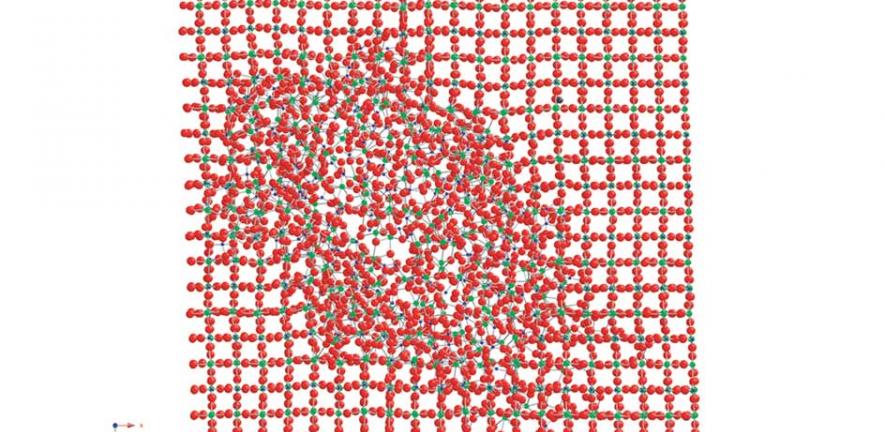
How can we make nuclear waste safe for millennia? Fundamental research led by the University of Cambridge will help find the answers.
How can we make nuclear waste safe for millennia? Fundamental research led by the University of Cambridge will help find the answers.
Our aim is to predict the chemical alteration of the fuel for ages between 1,000 and 100,000 years, which spans the lifetime of the disposal canisters.
Dr Ian Farnan
The timescale for keeping hazardous nuclear waste isolated from living organisms is unimaginably long, with times specified by nuclear regulators in Europe and the USA ranging from 10,000 to 1,000,000 years. Who knows what the human race, or indeed the planet, will be like 40,000 human generations from now.
Already, the world’s nuclear power plants, which generate around a fifth of global electricity, have yielded in excess of 300,000 tons of high-level nuclear waste, a figure that will dramatically increase in the context of a world nuclear renaissance. Most of the waste is currently stored above ground in spent fuel pools or dry storage. But, as the Fukushima accident in 2011 showed, above-ground nuclear waste storage is vulnerable and there is broad agreement among nuclear-generating countries that the best option is to bury it deep and inaccessibly in the Earth.
Understanding how to keep nuclear waste safe is clearly a considerable challenge, one that new research led by the University of Cambridge aims to help solve through fundamental studies of how nuclear materials behave, and are likely to behave, over massive timescales.
Led by Dr Ian Farnan from the Department of Earth Sciences, the study involves overcoming radiological protection issues to apply state-of-the-art analytical techniques to nuclear materials. These techniques are being used to quantify the atomic-scale interactions producing radiation damage and driving alteration processes.
The project is based on over a decade of pioneering research in which the researchers developed the first system to use nuclear magnetic resonance (NMR) under strict radiological safety constraints to look deep within radioactive material in its crystalline and amorphous forms – a transition that occurs during radiation damage. The new experiments, which are funded by the European Commission, are being conducted at a secure nuclear facility in Germany and will spread this research capacity throughout European nuclear organisations and universities.
Moreover, this new approach will critically test existing models of nuclear waste behaviour and allow regulators to implement sustainable solutions to the nuclear waste challenge through the development of scientifically robust safety cases.
“We already know that when you look at radiation damage with local atomic-scale techniques such as NMR then you see a lot more damage than was predicted by computer models or conventional measurement techniques,” said Farnan. “Swelling of the material is often taken as the first sign of radiation damage. We’ve found that pockets of damage are produced before swelling occurs and that swelling only really starts when these damaged areas join together. What this means is that the behaviour of the material is not linear – it can change dramatically over the small dose interval when this coalescence occurs.”
One particular type of nuclear waste is specific to the UK. Unlike in European countries and the USA, which elected to build a fleet of pressurised water reactors (PWR) or boiling water reactors (BWR), the main reactor type operating currently in the UK is the advanced gas-cooled reactor (AGR). “Traditionally, the UK has reprocessed its nuclear fuel rods to extract and reuse the uranium and plutonium,” explained Farnan. “However, due to problems with reprocessing facilities, the government is having to move away from reprocessing of AGR fuel towards disposal in a suitable geological repository. The difficulty for the UK is that much less is known about AGR than PWR/BWR spent fuel.”
Now, with funding from the Nuclear Decommissioning Authority and the Engineering and Physical Sciences Research Council, Farnan hopes to reverse this. “Our aim is to predict the chemical alteration of the fuel for ages between 1,000 and 100,000 years, which spans the lifetime of the disposal canisters,” he explained. “By the time a UK geological disposal facility is ready to accept waste, projected to be in about 30 years, we should be able to answer most questions about the long-term durability.”
Results of these two research projects will not only enable the researchers to underpin the safety cases for nuclear waste storage with fundamental science but will also have implications for predicting the integrity of radioactive material over millennia.
This work is licensed under a Creative Commons Licence. If you use this content on your site please link back to this page.





